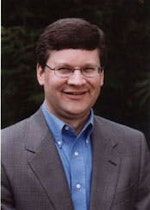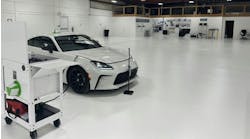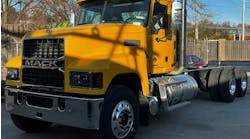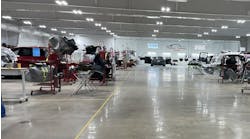The idea was simple enough: Bring together a small group of knowledgeable and articulate members of the collision industry, throw out some topics for them to discuss and then get out of the way.
The result: A unique collection of ideas, perspectives and prescriptions for the current issues facing the industry, and some predictions in what will be an annual roundtable.ABRN offers a glimpse into this roundtable discussion that it recently hosted, bringing together these seven representatives from shops, associations and one insurer:
- Dan Bailey, president and chief operating officer for the CARSTAR collision repair franchise chain.
- Denise Caspersen, collision division manager for the Automotive Service Association (ASA).
- Andy Dingman, general manager and part owner of Dingman's Collision Center in Omaha, Neb., and a board member of the Society of Collision Repair Specialists (SCRS).
- Nick Kostakis, owner of Angelo's Auto Body in Irvington, N.J., and a past national president of the Alliance of Automotive Service Providers (AASP).
- Dan Risley, a staff claim analyst with Allstate Insurance in Northbrook, Ill., and former executive director of the Society of Collision Repair Specialists (SCRS).
- Aaron Schulenburg, executive director of SCRS.
- Gigi Walker, owner of Walker's Auto Body in Concord, Calif., and president of the California Autobody Association.
ABRN: Let's start with one of the topics making the most headlines in the industry: non-OEM structural parts. We're seeing a lot of different approaches to the issue. If you had to choose the one that seems most likely to improve the situation, which would it be?
Schulenburg: We need to start with some open and publicly accessible testing results. People have done testing of these parts, but I think one of the drawbacks is that the raw data and results aren't publicly available to the industry. The results and perception of one test are issued, and the results and perception of another test are issued, and they may contradict one another. So we continue to go back and forth and challenge quality and safety. But I think if we as an industry were able to make that testing transparent and publicly available, anyone who wanted to could look at it and see: Are these parts like kind and quality?
Caspersen: I agree on the need for testing the parts. An ASA task force went to the National Highway Traffic Safety Administration (NHTSA) asking for just that: third-party testing of aftermarket parts. We all know that parts certification is available in the industry. Unfortunately it's very limited, and it doesn't have the trust of repairers. There's a need for a third-party entity that would regulate aftermarket parts to ensure quality and safety. NHTSA currently has that authority, and implements it with OEM parts. So to ask for that same kind of oversight of aftermarket parts seems very reasonable.
Walker: I agree with Denise. I really think there's also a lack of parts manufacturers getting involved here. It seems like whenever there's a problem, the parts distributor gets caught in the middle along with the body shop. The manufacturers of these parts have not come forward. They're on the sidelines watching what's happening, and I find that disturbing.
Bailey: I strongly believe these parts need to be tested and there needs to be a certification program. But also what about the hundreds or thousands of these parts that have been installed? I had hoped the industry would pretty much demand some type of recall process to protect the people whose cars we repaired for them.ABRN: Dan, what do you see about the non-OEM structural parts issue from an insurer's perspective.
Risley: Allstate's position has been and continues to be that we don't write estimates that contain structural aftermarket parts. That's been a policy long in place. But I think the best remedy for the issue is parts testing and certification. We're aware of at least one company that is currently testing these parts – and not just static tests, but dynamic testing, which is pretty critical for structural parts. Allstate continues to monitor the situation for any potential new developments in terms of manufacturing, testing or certification process. But as of right now, use of non-OEM structural parts isn't something we'd consider.
ABRN: For the shop representatives here, what are one or two things you'd most like to see state or national trade associations address?
Dingman: Probably at a national level, one of the things I'm worried about is data privacy with the information providers. I see us evolving into this whole cloud-based hosting for all our estimating and management systems.
ABRN: That's where rather than running that software on computers at your shop, the systems and your data are on the information provider's centralized computers that you access via the Internet.
Dingman: Right, and I see a lot of good with that. That being said, I also need to feel comfortable that my information going out is going to be exclusive to myself and that I get to determine who sees it and what gets done with it.
Walker: I'd like to see more of the associations work together. When you're sitting on an association board and trying to work with other boards, sometimes there are some serious separation issues when we should all be uniting over certain causes. Look at the aftermarket parts question: We should all be going in one direction on that, and we're not.
Kostakis: I'm going to agree with both of these, data privacy and the disadvantage we put ourselves in when we fight issues on multiple fronts. I think data privacy is a good example. If we were all working off the same paper, we would have all gotten together on this issue a couple of years ago when it first started being talked about, and we would have formed a united singular strategy. Even if these various trade associations have to exist separately for whatever reason, we can certainly on behalf of our individual and collective members fight some of these issues together. That's just not happening to the extent that it should be. It puts us at a disadvantage.
ABRN: Denise or Aaron, from an association standpoint, would you like to comment?
Schulenburg: One of the challenges we have is getting more out about the good work that is being done between associations. There's a lot work we have done collectively addressing some of these very issues.
Caspersen: Yes, I would be hard-pressed to say where we're not working together, honestly.Schulenburg: Just in terms of the information providers, for example, we're all on the Database Taskforce through CIC (Collision Industry Conference) as well as jointly establishing and maintaining the Database Enhancement Gateway (DEG). One of our top priorities is promoting communication from association to association. We have monthly calls between the state associations, trying to help them learn from each others' experiences and successes, and to bounce ideas back and forth.
ABRN: Certainly the economy remains a clear concern for business owners. Based on what you're seeing, how would you rate its impact in the next six months to a year, with '10' being 'very optimistic' and '1' being 'very pessimistic.'
Walker: I'm optimistic because that's my nature. I'm going to say a '7.' My business has been down both on the fleet side and the insurance side. But I'm seeing some rebound. I'm getting out there and actually hitting the pavement and going to my fleet accounts and offering discounted services. That's what we have to do to keep the doors open.
Dingman: I guess I'm going to say a cautious '8.' I'm cautiously optimistic. The second quarter of this year was our best in business.ABRN: Dan, CARSTAR has franchises throughout the country. What are you seeing?
Bailey: Florida, Arizona and Western Michigan are the areas really suffering. The rest of the country is doing pretty well. I'd answer your question with a '6.' It feels like it's stabilized. The number of calls I get from our 260 stores needing advice or help – how do we get cars in the door, how do we cut overhead – that seems to have stabilized. But I do think the economy could still go either way. We are seeing more higher deductibles, and more people cashing out or making temporary repairs on their vehicle. But I'm cautiously optimistic.
Kostakis: I wouldn't give it more than a '5.' The economy is a major issue, but within our industry, the over-capacity that continues to plague us is not going to go away in the short-term. I think we have a lot of shops operating below break-even but hanging on because they have nowhere else to go. Until that capacity permanently leaves the industry, there's just not going to be enough work to go around. I don't see too much sunshine in the short term.Caspersen: I would say I'm a '6,' hoping for a '7.' The market does have too many repair facilities. But I've talked to some ASA members who have grown their business this past year. That's exciting for the 15 to 20 percent of the market that is able to do that.
Risley: I would look at it as '5' or '6.' We're not seeing a big rebound in claims count and frequency. Bankruptcy and unemployment is still on the rise, and the housing market isn't bouncing back. From a general economy perspective, we're not moving anywhere in the next six months. But a year out, maybe we can start looking at a '7' or '8.'Schulenburg: I'm fairly optimistic. I think with the challenges, more repairers are looking for answers and becoming more involved. So I think the silver lining is while it's challenging for individual businesses, this may provide some positive results for the industry. To that end, I'll give it maybe a '7.' Even as the economy comes back, we're not going to come back to a boom. Consumers have changed their spending habits significantly. They aren't going to automatically revert. So shops need to look at cosmetic repairs and at other service offerings more in line with the consumer's new buying perspective. My level of optimism is higher for those businesses that have adapted versus those just waiting for a return to the way it was.
ABRN: Now could you look a little further out, say, three years from now, mid-2013. What do you think will look different in your business or the industry?
Walker: In the state of California specifically, I foresee serious movement toward technician certification.Bailey: As Nick said, we definitely have overcapacity today, and we're going to see that correct itself. If I had to look in that crystal ball, I think we'll be down close to 20,000 stores in the industry, the average store will have about $2 million a year in revenue, and there will be more regional multiple-store operators. 'Green' is going to be much more important to customers and to insurers. I think the work is going to flow to the kind of store that's wiling to adapt and to invest in their facility and equipment and in training for their employees.
Risley: The relationship between repairer and insurer is going to continue to evolve and it's not specific to just DRP. A large percentage of our customers don't use our DRP. So one of the things we're looking at over the next three years is trying to help streamline the process for our customers and shops not participating in our DRP. I think you'll see some innovation as we incorporate more of our technology into the process to make it easier for everybody involved. The technology is also going to allow insurance carriers to identify and potentially even reward those repair facilities that are providing a better repair and a better experience for the customer. We understand who the better performers are more so than we ever have in the past.Schulenburg: Technology from the consumer care standpoint also is going to change. The younger generations of drivers have different buying habits. They are less inclined to take referrals and more inclined to seek peer-to-peer advice through social networks. So I think while shops have not traditionally done a lot of marketing to the consumer, Internet-based marketing and social networking offers cheaper and more effective mechanisms for shops to directly reach consumers. I think there's going to be a much closer relationship forged directly with the consumer three years from now.



